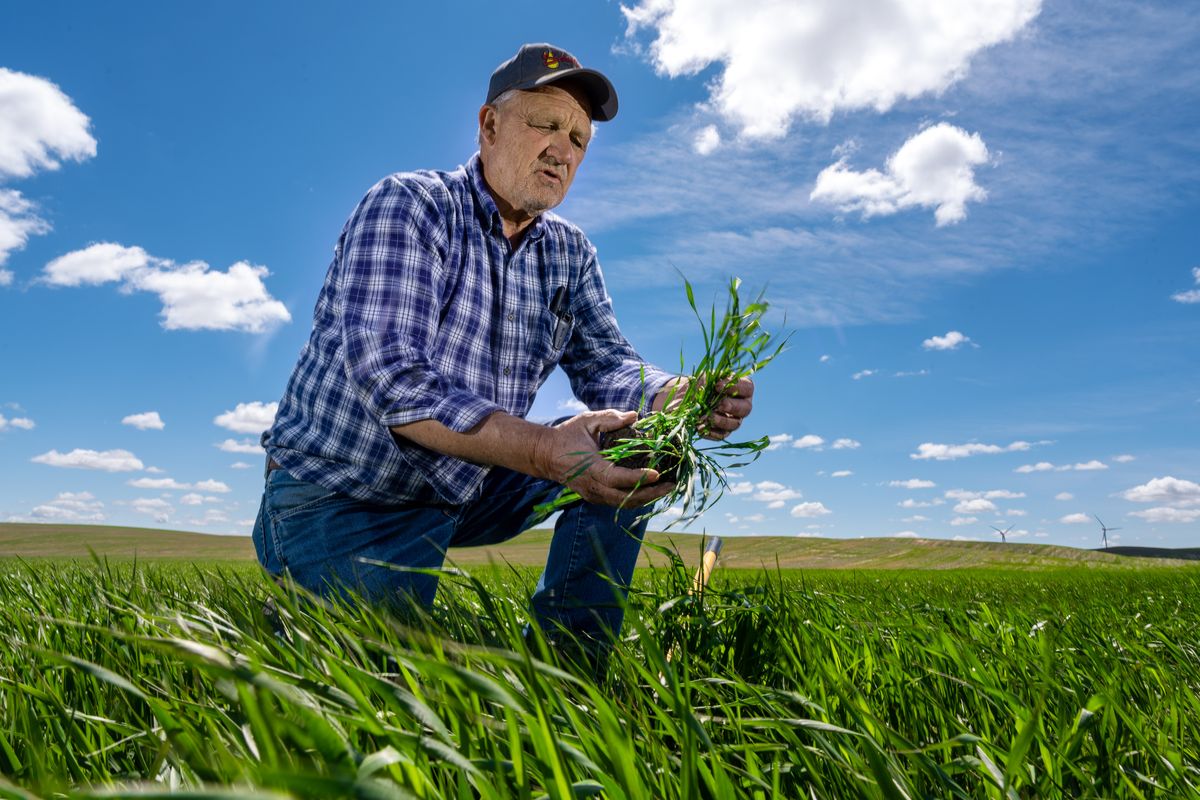Drought has these Eastern Washington farmers worried, but they ‘always plant with faith’

OAKESDALE, Wash. – Wednesday was an immaculate day on the Palouse.
Cartoonishly puffy clouds filled a brilliant blue sky. A gentle breeze blew through the 65-degree air. Hill after hill of bright green wheat rolled away for miles in every direction.
Palouse farmers are sick of beautiful days, though.
They want ominous gray clouds to bring rain and bring it now. They’re getting worried about the lack of moisture.
“This is the second-driest year I’ve seen since 1977,” farmer Roger Pennell said.
Pennell dug a shovelful of ground out of his wheat field on Wednesday afternoon to show his soil. To the untrained eye, there wasn’t anything remarkable about the dark-brown lump of dirt with a few blades of wheat popping out of it.
But Pennell could see it wasn’t quite right.
“Normally, this time of year, it’d be muddy,” he said, kneading a clump of the soil with his hand. “If you can’t make a mud ball, you’re dried out pretty good.”
Farmers in the Palouse and throughout Washington have gotten little rain since March. This has been the second-driest spring in recorded Spokane history, and the driest since 1924.
The lack of moisture won’t impact all farmers equally. In general, farmers farther south and west – in Yakima, Klickitat, Benton and Walla Walla counties, for instance – will be hurt most.
Growers say they expect almost all of Eastern Washington’s farmers to have below-average grain and pulse harvests at best, even if a few downpours hit soon. Yields, and therefore profits, will suffer. For farmers closer to the Idaho border, some timely rains would be a godsend, but it could be a memorably bad year.
“It’s going to be dependent on the next three weeks,” Palouse farmer Kevin Paulson said. “Three inches of rain would change everything.”
At nature’s mercy
Nearly all of Washington is in moderate to severe drought, according to the U.S. Drought Monitor.
Eastern Washington is mostly a dryland farming region. Producers don’t divert water or irrigate their fields with sprinklers. Their plants can’t grow without rain.
“We can’t turn on the irrigation,” Whitman County farmer Gary Bailey said. “Mother Nature does that for us, and she seems to have taken a break this year.”
Farmers can see signs of the drought already.
The blades of wheat are bluer than normal, not their typical healthy green. Plus, the plants are short and undeveloped, which gives the fields a different look.
“I can see between the rows,” Pennell said, noting the lines of brown soil still showing in his field. “That’s not good.”
Michelle Hennings, executive director of the Washington Association of Wheat Growers, said she’s heard some concerning reports from farmers in southern Washington whose wheat is only a foot high but already has developed heads – the grain-producing part of the plant.
Those tiny, water-starved wheat plants will produce smaller, and fewer, kernels.
“That will then cause a reduction in yield, drastically,” Hennings said. “That will definitely affect the farmer’s bottom line.”
Pennell said he’s heard of some farmers in central Washington who could begin plowing their wheat under, giving up on this year’s harvest in order to conserve moisture in their fields and hope for a better year in 2022. Hennings said she hasn’t yet heard of anyone plowing under their crop.
Glen Squires, CEO of the Washington Grain Commission, said it’s difficult to know precisely how the drought will hurt farmers financially.
“One blanket statement does not work,” he said.
The vast majority of farmers have crop insurance, but the drought will still cause significant financial losses for many producers.
Squires said he expects the luckiest farmers will have average yields this year.
Farmers closer to Idaho will be better off – Washington mostly becomes drier as you head west until the Cascades. The dropoff happens quickly. Farmers in eastern Whitman County usually get 50% more rain than those on the western side and will be better positioned to deal with the drought.
Rains can be spotty, too. Aaron Flansburg, who farms near the town of Palouse, said his cousin got a half-inch of rain on Tuesday. Flansburg didn’t get any, even though his farm’s just 5 miles west.
For farmers in southern and central Washington, it could be too late for a saving rain. Their wheat plants mature sooner, and once a plant has matured, the size of the yield is determined.
For farmers farther east, there’s a roughly three-week window. If rains come now, they could lead to big growth spurts before the plants develop heads, which would push yields a bit closer to average.
“I think we’re going to definitely take a yield hit,” said Dan Schmitz, who farms near Rosalia. “Every day the plant’s not growing equates to yield loss.”
Every year’s a gamble
Last year’s growing season got off to a bad start with a dry spring.
Then the rains came in May and June and plants grew.
“We ended up having the second-largest crop in history,” Squires said. “It shows you what a little moisture does.”
Rains this past weekend helped out farmers, but they weren’t torrential and they didn’t hit every part of the region and state. And there aren’t any signs that more substantial rains could be coming soon.
Drought or no drought, Pennell was relaxed at his spring wheat field Wednesday. A lone barn swallow kept swooping low over the ground a few feet away, tittering. Wind turbines spun behind the hills to his left. At one point, he waved as a tractor passed and kicked a cloud of dust over him.
Pennell is a third-generation Palouse farmer. He’s been working this ground for 40 years, and he’s not panicking.
There isn’t any point, he said, because he can’t control the weather.
“It’s not unusual to see this,” he said. “It’s called farming. We always plant with faith.”